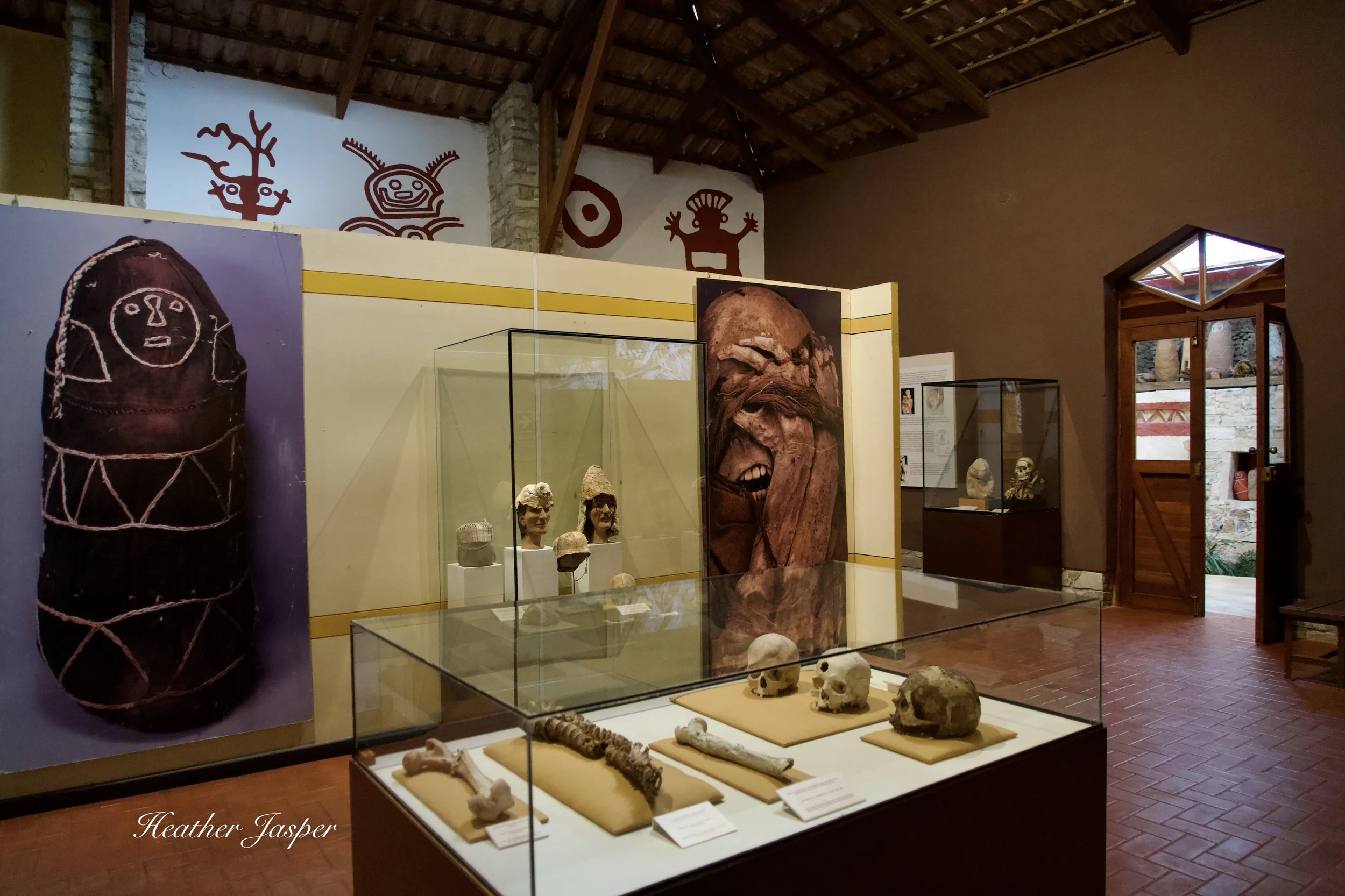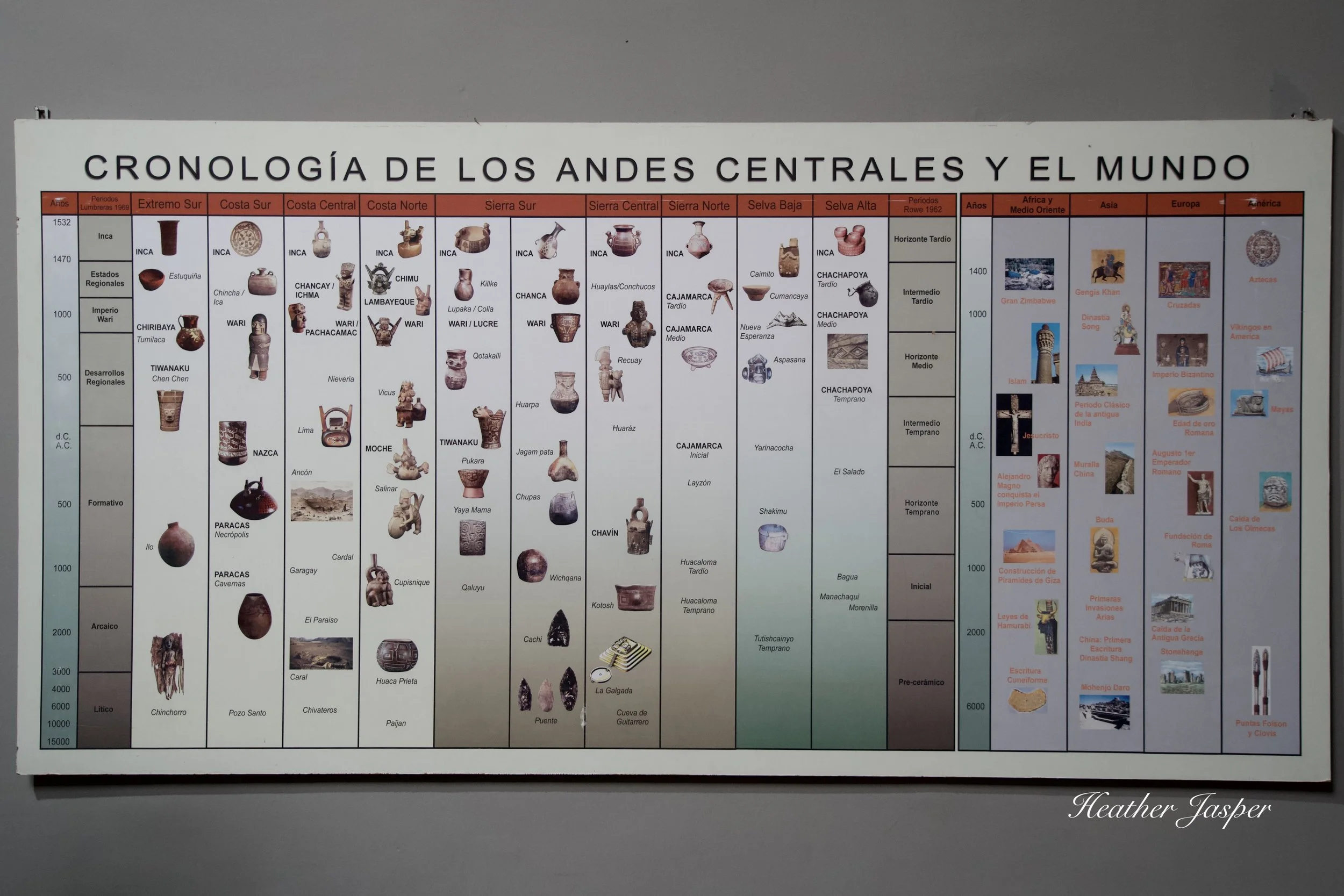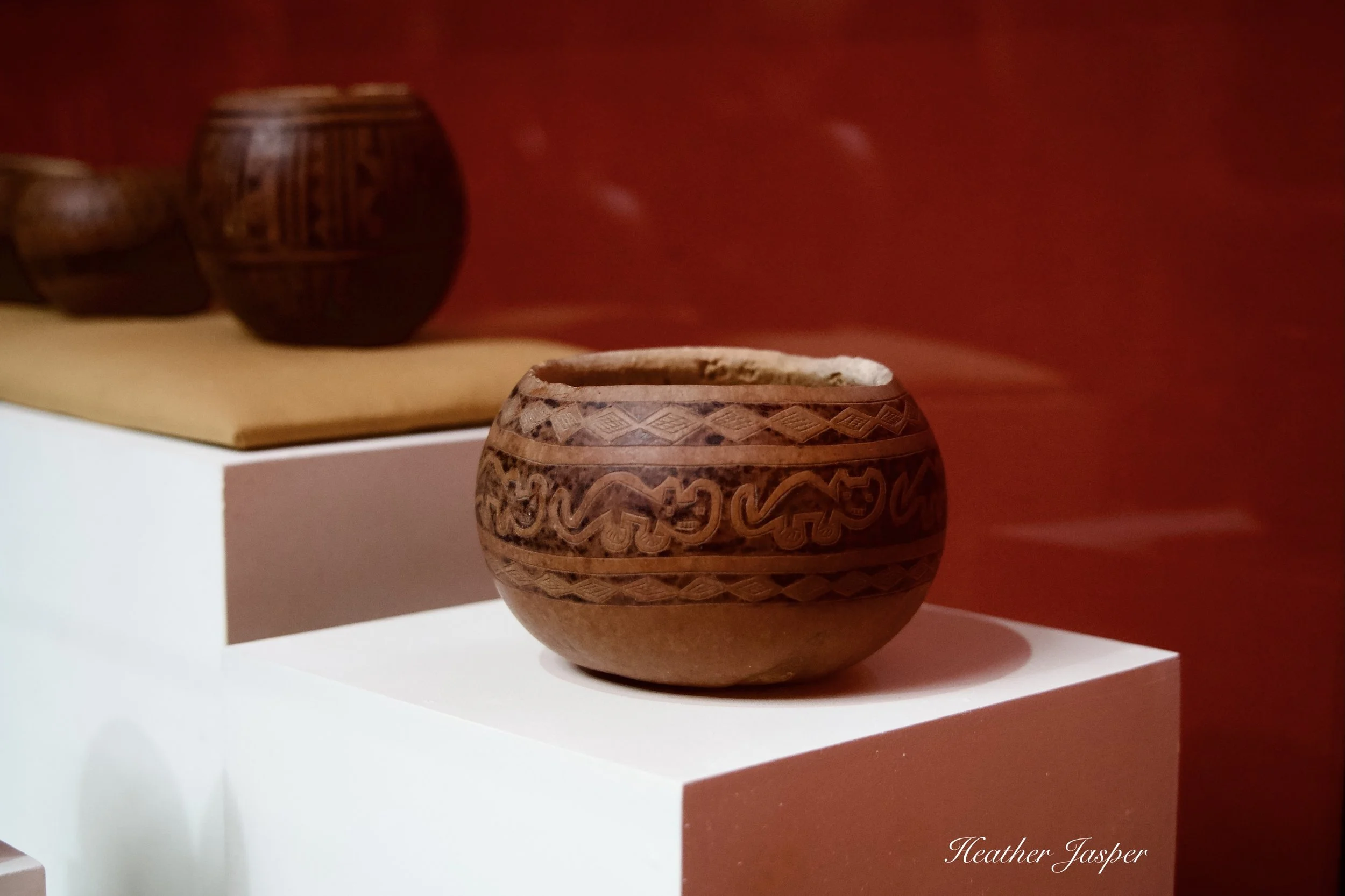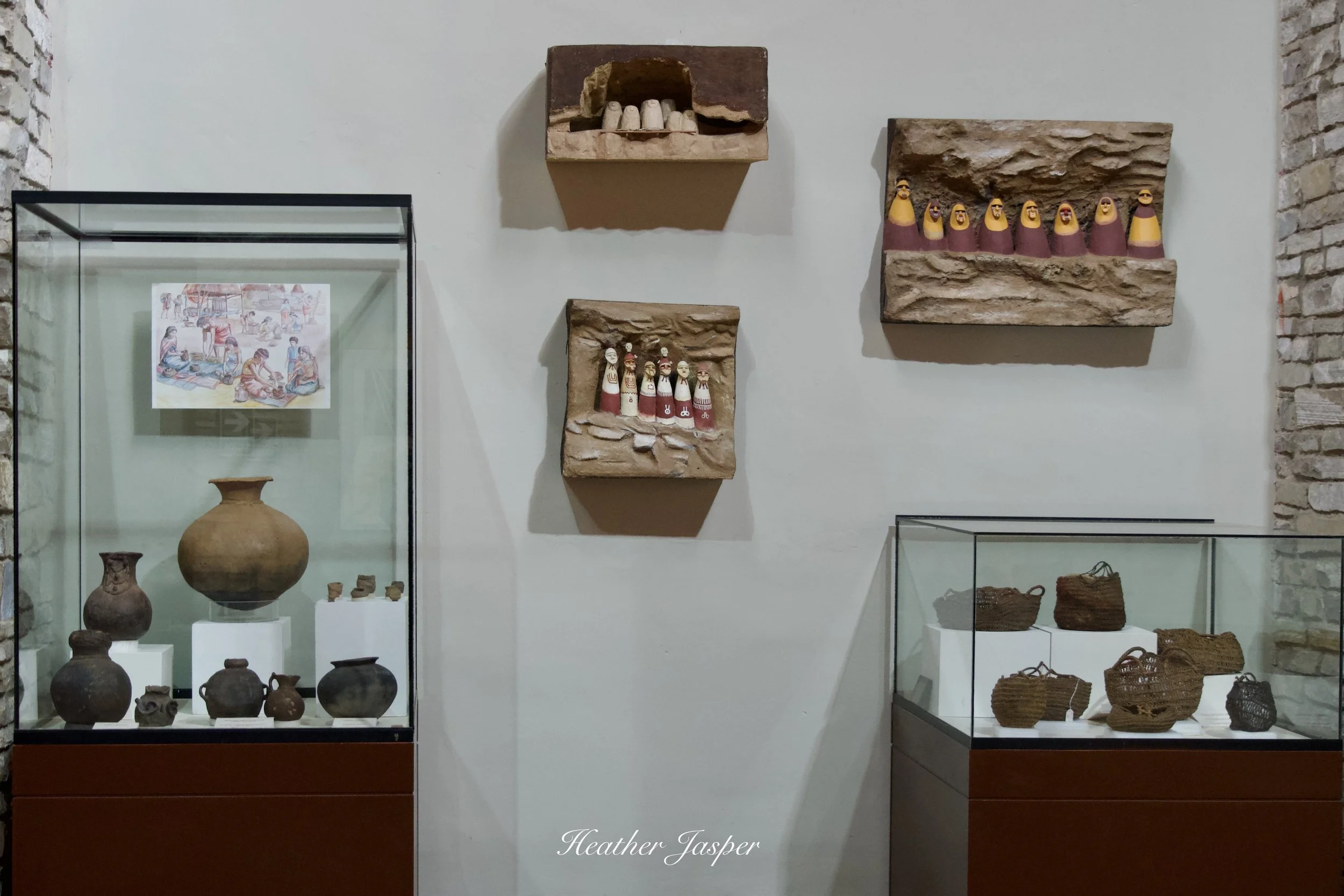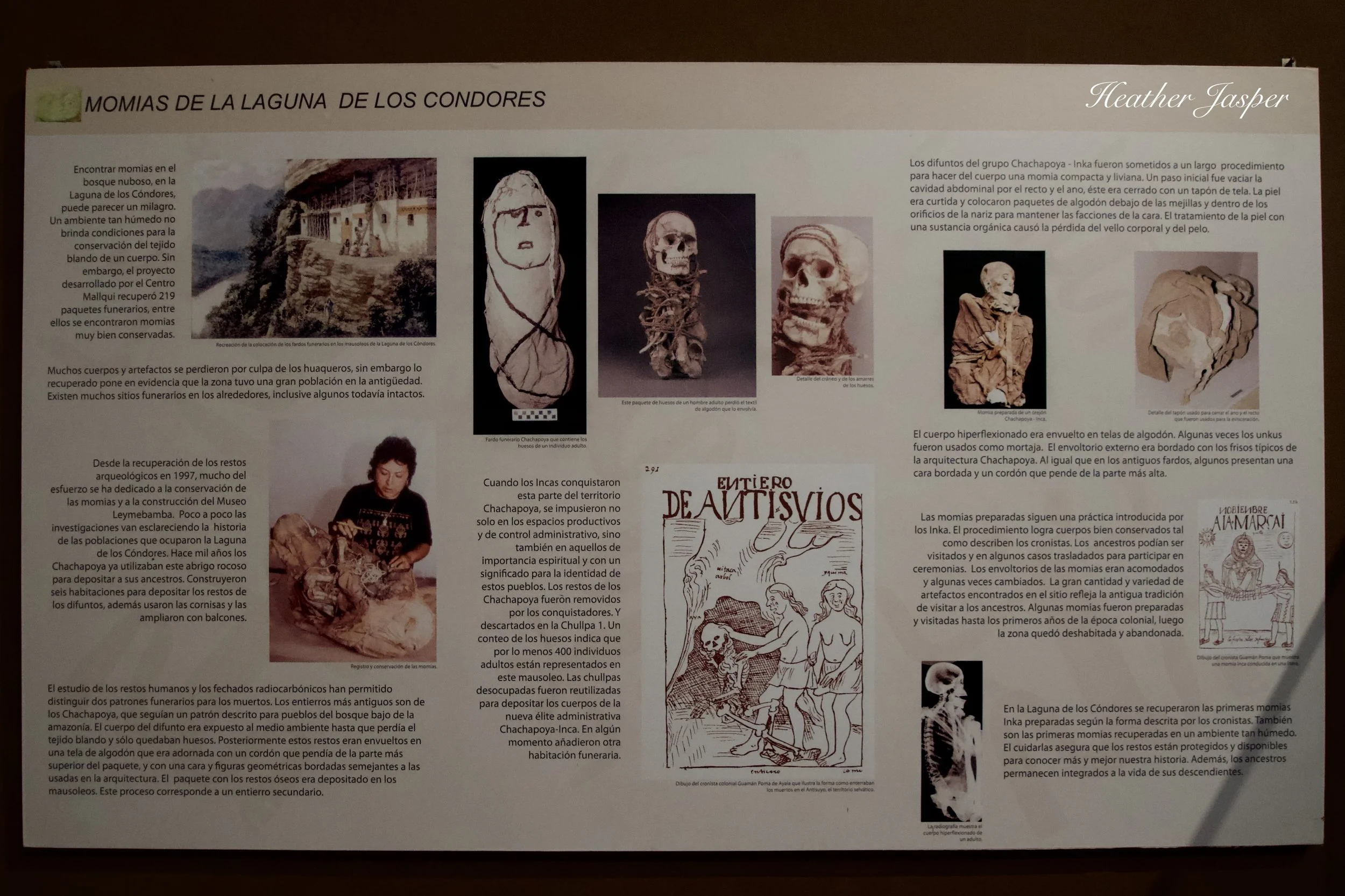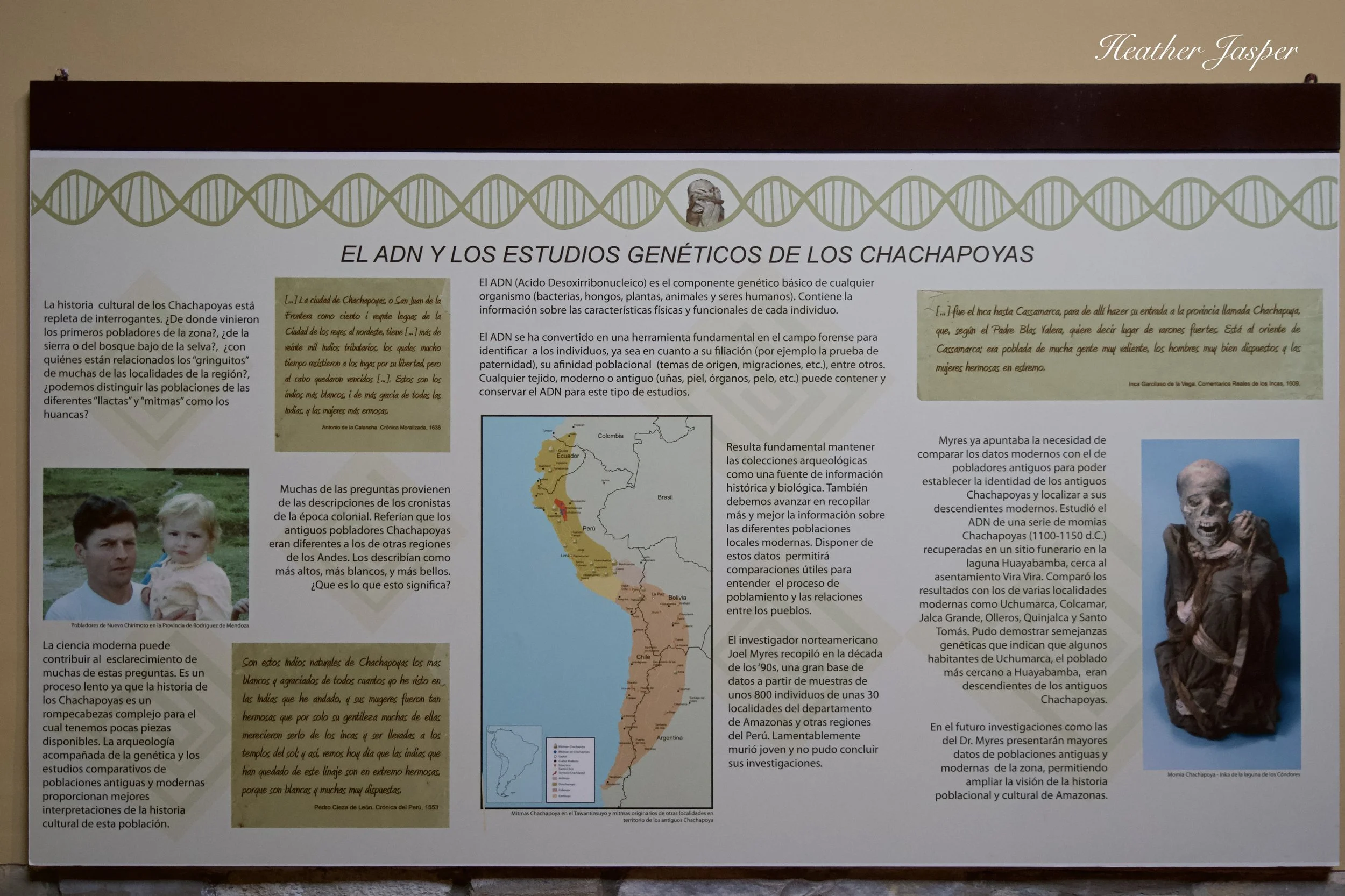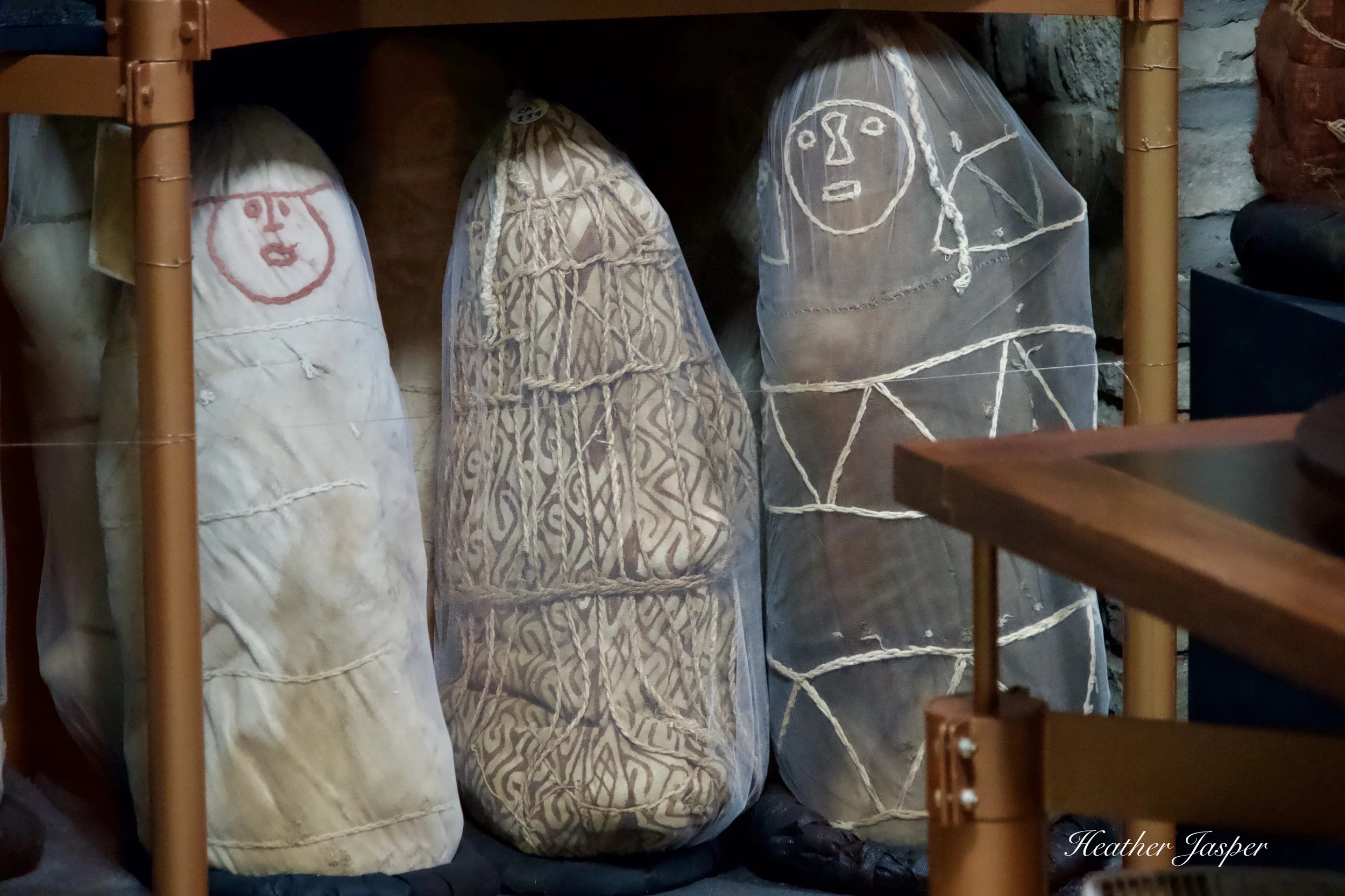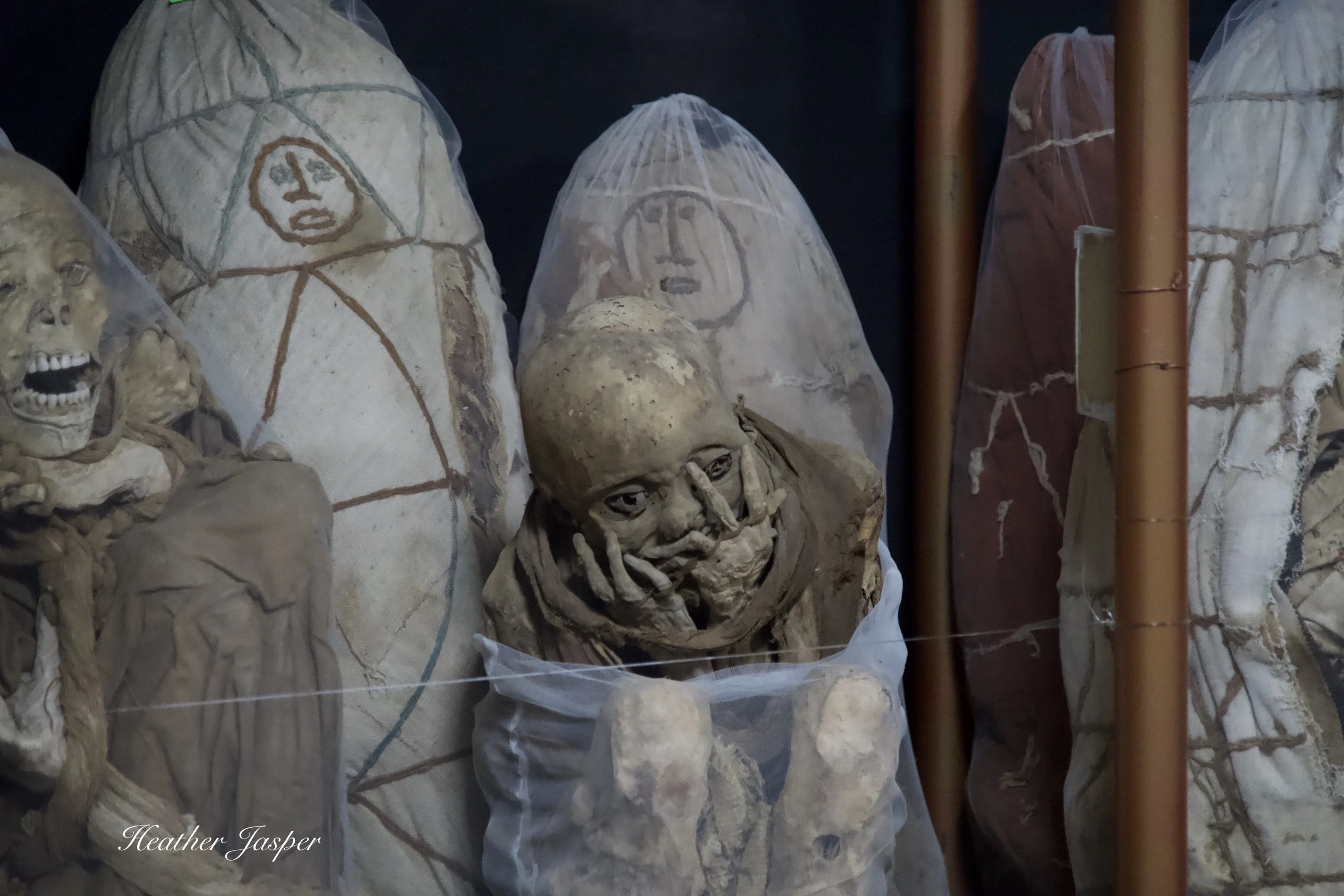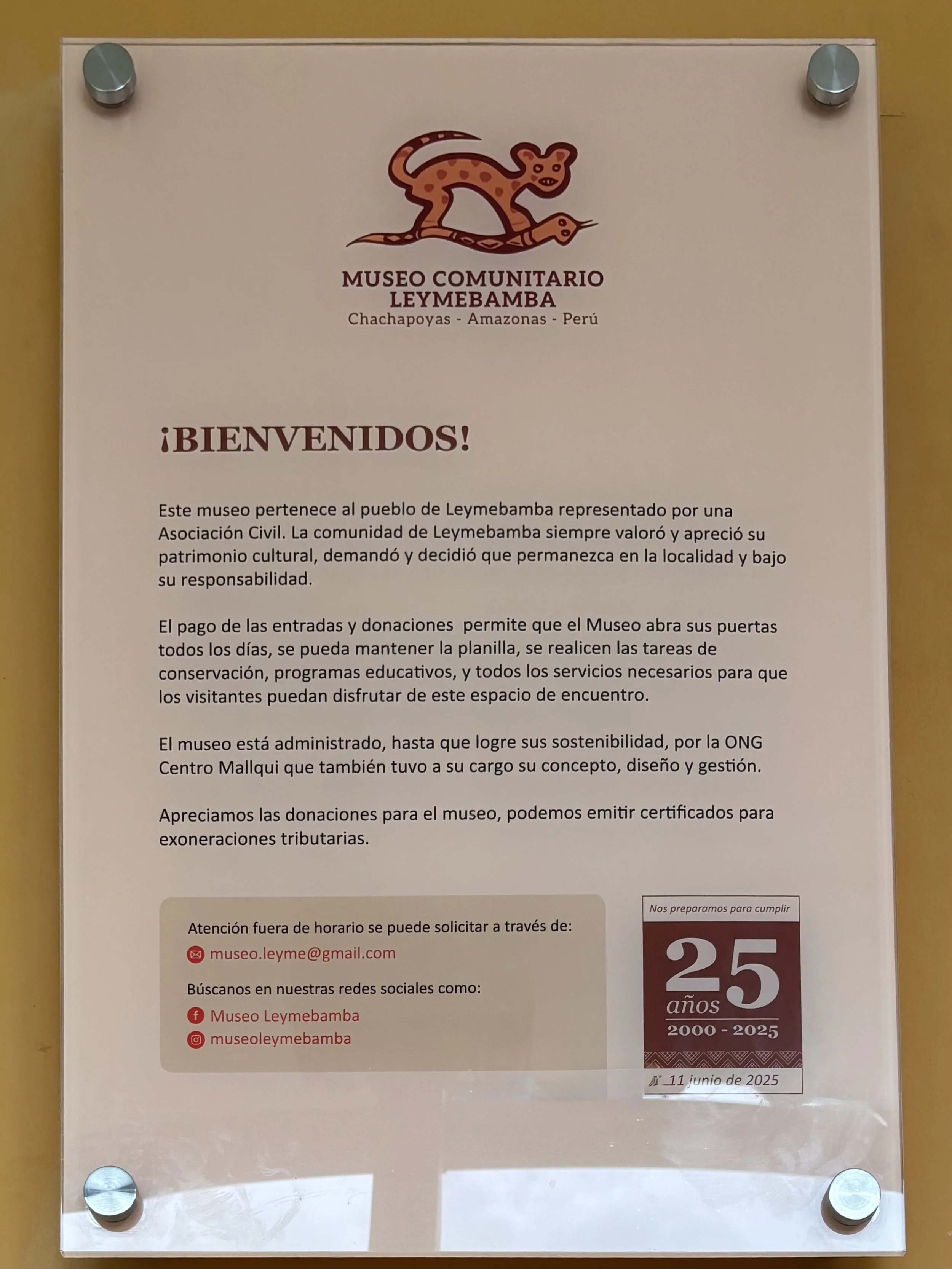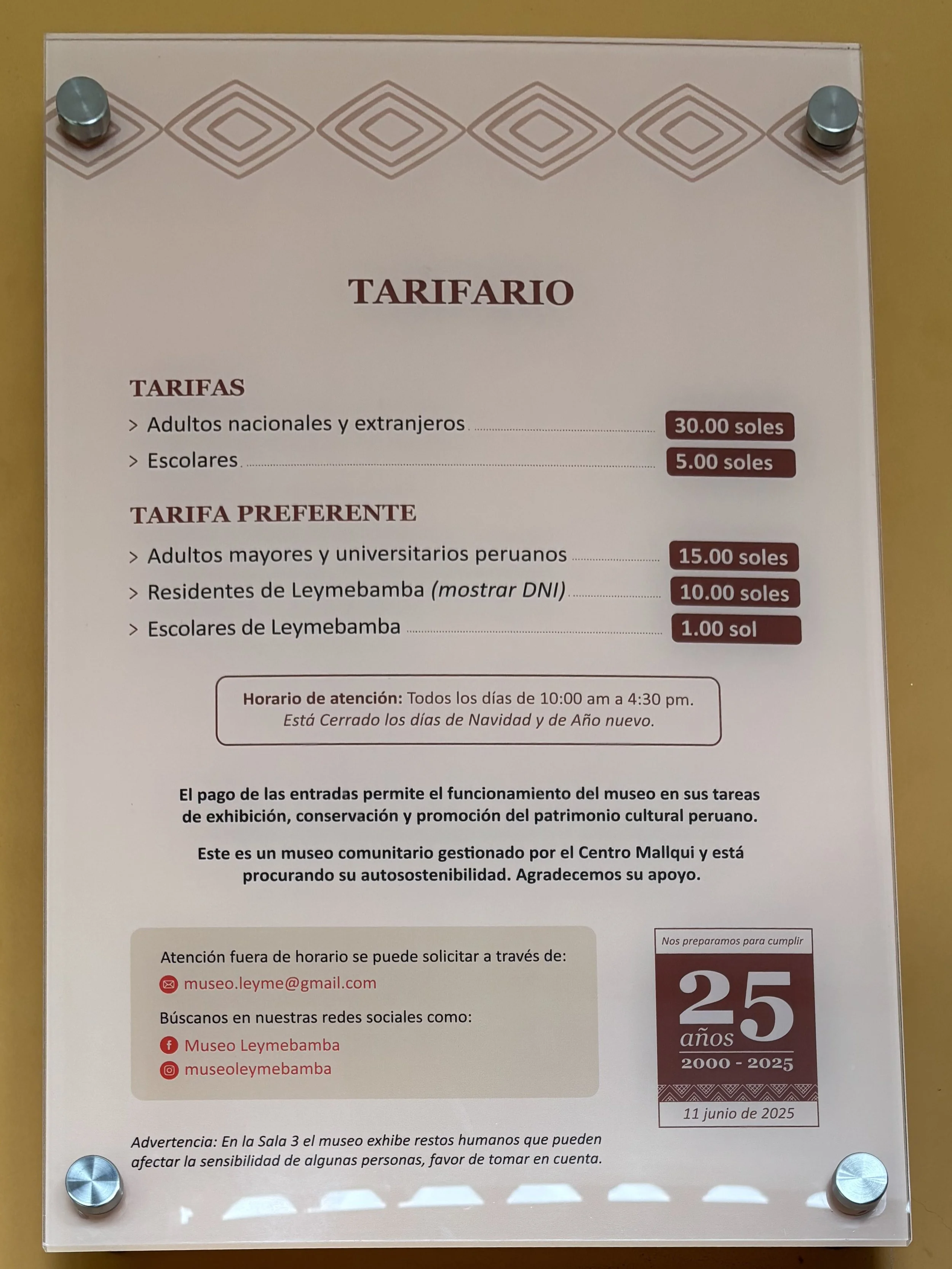Leymebamba
The Chachapoya ruled Peru’s northern cloud forests for over 900 years.
The Chachapoya mummies were wrapped in a bundle, like the one on the left with an embroidered face.
The Chachapoya made unique mummies.
Most mummy-making cultures around the world, from Egypt to China to the Nazca and Inca in Peru, created a process that preserved the skin and hair. That the Chachapoya didn’t try to preserve the body makes their burial practice more like skeletal preservation, rather than a typical mummy process.
Like the family members people buried under their homes in Kuélap, when somebody died, their body was buried in a temporary grave until the worms had disposed of the soft tissue and what was left was mostly bones. Then, the bones were gathered up and wrapped in a bundle, with the skull perched on top, then the whole bundle was wrapped in a shroud, and a face was embroidered on the outside.
Center-right, under the world “centrales” is Selva Alta, high jungle, with the Inca and Chachapoya.
The indignities of gravity
Many skulls were tied to keep the jaw shut, though if the rope came loose or disintegrated the jaw would fall open. Other mummies were bundled with the hands holding up the jaw. (If you’re sitting at a table, put your elbows on the table and then rest your chin and jaw in your palms, with your thumbs by your earlobes). Some mummies look like they’re screaming, but it’s just because gravity pulled down the jaw.
I didn’t include a lot of mummy photos, because some people are squeamish and I don’t need to freak or gross anybody out. I don’t think they’re scary or gross and there is only one photo below.
Feline Iconography
The Chachapoya, like the Inca, used a lot of feline forms in their art. Archeologists say these more likely represented jaguars than pumas.
Those mummy bundles were placed in mausoleums, often with many mummy bundles sharing a tomb. The most impressive Chachapoyan mausoleums were in a cliff above the Lake of Condors, also called Lake of the Mummies and Laguna de los Cóndores in Spanish.
Hanging on the wall are miniatures of what the cliffside mausoleums look like.
How to see the Lake of the Condors?
Most people go by horse with a local tour company for a 3-day, 2-night tour. The first day is 8-9 hours on a horse, the second day you get to visit the lake and mausoleums and the third is the return. You spent both nights in some rustic cabins near the lake. This is also an excellent place for birders, as the birdlife in this part of the Peruvian cloud forest is amazing.
How to see the mummies?
Unfortunately, all the mummies were stolen by looters or moved around in the mausoleums, destroying information that archeologists could have used to learn about each person. In 1997, 219 were recovered from the cliffside mausoleums above Lake of the Condors, in a massive rescue operation, but many were lost forever to the black market of antiquities. Most buyers are not in South America, so the mummies not recovered or destroyed are most likely in North America, Europe and Asia.
More than 200 Chachapoya mummies are housed in the Leymebamba Museum.
The rescued mummies are safe in the Leymebamba Museum, also called Centro Mallqui. In Quechua, mallqui means ancestor or wise person. They are kept in a climate-controlled room to ensure their preservation. Obviously, returning them to their mausoleums would only invite more looters to finish the job.
The mummy bundles all have a fine mesh bag to protect the ancient cotton shroud from touching anything.
The mummies are in the last part of the museum.
Besides the unrecovered bodies and artifacts, the looters stole all the information archeologists could glean from finding the mummies as their children and grandchildren had placed them. Looters ransacked the mausoleums for anything made of gold or silver, often slashing open the bundles with machetes to look inside. It was one of the worst acts of desecration Peru has suffered in recent years. We lost the artifacts placed with each body and the context of who was placed next to who.
Each mummy at the museum has a medical file, which includes all of their x-rays, CAT scans and genetic testing. We know which mummies are related, though we don’t know who they were next to in the mausoleums.
Young mummies
Later mummies were treated with a salve that preserved their skin, but took off all their hair. This young woman was one of the more recent mummies, from the 1400s.
I get that some people don’t like seeing dead bodies, but I liked seeing the mummies at Leymebamba. I especially liked seeing them together, in a place where people respect and care for them. A private museum on a different continent is definitely a fate worse than death.
Do not support the black market!
I shouldn’t have to say this, but please do NOT buy any antiquities in or from Peru. It is all 100% illegal and just plain wrong. Lest you think that’s a thing of the past, a few years ago one of my neighbors in Cusco (two blocks away, who I didn’t know) was arrested with 12 wooden crates in his home, ready for export. There were two mummies in one of the crates. He was preparing to send somebody’s grandparents off to whoever buys mummies on the black market. This is very much still a problem in 2025.
How to get to Leymebamba?
The best way to visit Leymebamba is with a tour that includes Revash.
The town of Leymebamba is south of the city of Chachapoyas. In theory, the drive only takes about two hours. In practice, it’s much longer because the road is in terrible shape. It’s full of potholes and in sections the asphalt has completely disintegrated, leaving muddy washboards. A pickup with good suspension can probably get there in two and a half hours. A van or bus may take over three hours, and a car would be just as bad. If I get word that they’ve resurfaced the road, I’ll update this blog.
Museum hours and price
The museum is owned by the community of Leymebamba and opened in 2000. The entrance fee is s/30, with discounts for students and retired people. It’s open every day 10am to 4:30pm.

